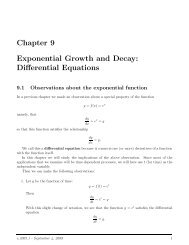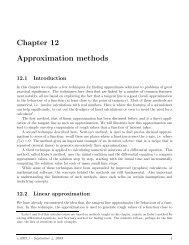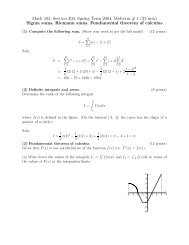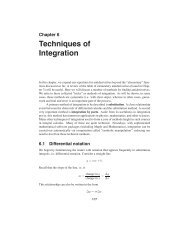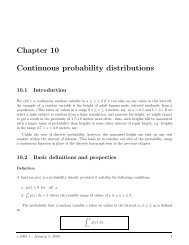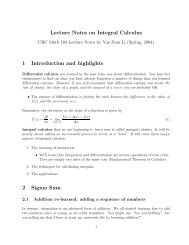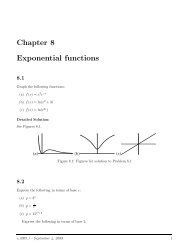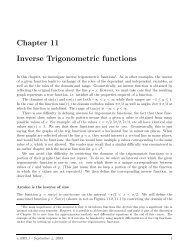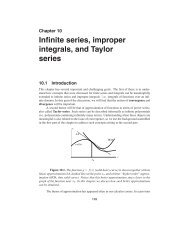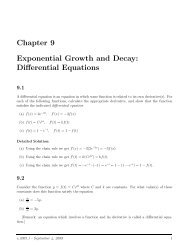Chapter 10 Trigonometric functions - Ugrad.math.ubc.ca
Chapter 10 Trigonometric functions - Ugrad.math.ubc.ca
Chapter 10 Trigonometric functions - Ugrad.math.ubc.ca
Create successful ePaper yourself
Turn your PDF publications into a flip-book with our unique Google optimized e-Paper software.
Math <strong>10</strong>2 Notes <strong>Chapter</strong> <strong>10</strong><br />
<strong>10</strong>.3 Properties of the trigonometric <strong>functions</strong><br />
We now explore the consequences of these definitions:<br />
Values of sine and cosine<br />
• The radius of the circle is 1. This means that the x coordinate <strong>ca</strong>nnot be larger than 1 or<br />
smaller than -1. Same holds for the y coordinate. Thus the <strong>functions</strong> sin(t) and cos(t) are<br />
always swinging between -1 and 1. (−1 ≤ sin(t) ≤ 1 and −1 ≤ cos(t) ≤ 1 for all t). The peak<br />
(maximum) value of each function is 1, the minimum is -1, and the average value is 0.<br />
• When the radius vector points along the x axis, the angle is t = 0 and we have y = 0, x = 1.<br />
This means that cos(0) = 1, sin(0) = 0.<br />
• When the radius vector points up the y axis, the angle is π/2 (corresponding to one quarter<br />
of a complete revolution), and here x = 0, y = 1 so that cos(π/2) = 0, sin(π/2) = 1.<br />
• Using simple geometry, we <strong>ca</strong>n also determine the lengths of all sides, and hence the ratios of<br />
the sides in a few particularly simple triangles, namely triangles (in which all angles are 60 ◦ ),<br />
and right triangles with two equal angles of 45 ◦ . These types of <strong>ca</strong>lculations (omitted here)<br />
lead to some easily determined values for the sine and cosine of such special angles. These<br />
values are shown in the table below.<br />
degrees radians sin(t) cos(t) tan(t)<br />
0 0 0 1 0<br />
π<br />
30<br />
6<br />
π<br />
45<br />
4<br />
Connection between sine and cosine<br />
1<br />
√2<br />
2<br />
√2<br />
3<br />
2<br />
√<br />
3 1√<br />
√2<br />
3<br />
2<br />
2<br />
1<br />
√<br />
π<br />
1<br />
60<br />
3<br />
2 3<br />
π<br />
90<br />
2<br />
1 0 ∞<br />
• The two <strong>functions</strong>, sine and cosine depict the same underlying motion, viewed from two<br />
perspectives: cos(t) represents the projection of the circularly moving point onto the x axis,<br />
while sin(t) is the projection of that point onto the y axis. In this sense, the <strong>functions</strong> are a<br />
pair of twins, and we <strong>ca</strong>n expect many relationships to hold between them.<br />
• The cosine has its largest value at the beginning of the cycle, when t = 0 (since cos(0) = 1),<br />
while the other the sine its peak value a little later, (sin(π/2) = 1). Throughout their circular<br />
race, the sine function is π/2 radians ahead of the cosine i.e.<br />
cos(t) = sin(t + π 2 ).<br />
• The point (x, y) is on a circle of radius 1, and, thus, its coordinates satisfy<br />
x 2 + y 2 = 1<br />
v.2005.1 - September 4, 2009 4



